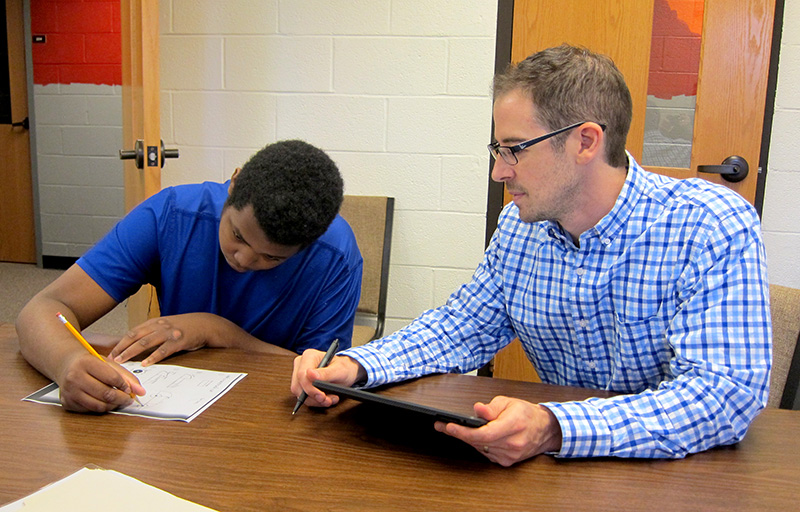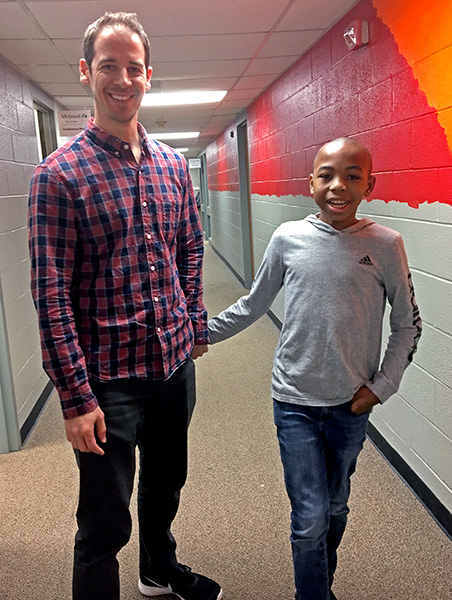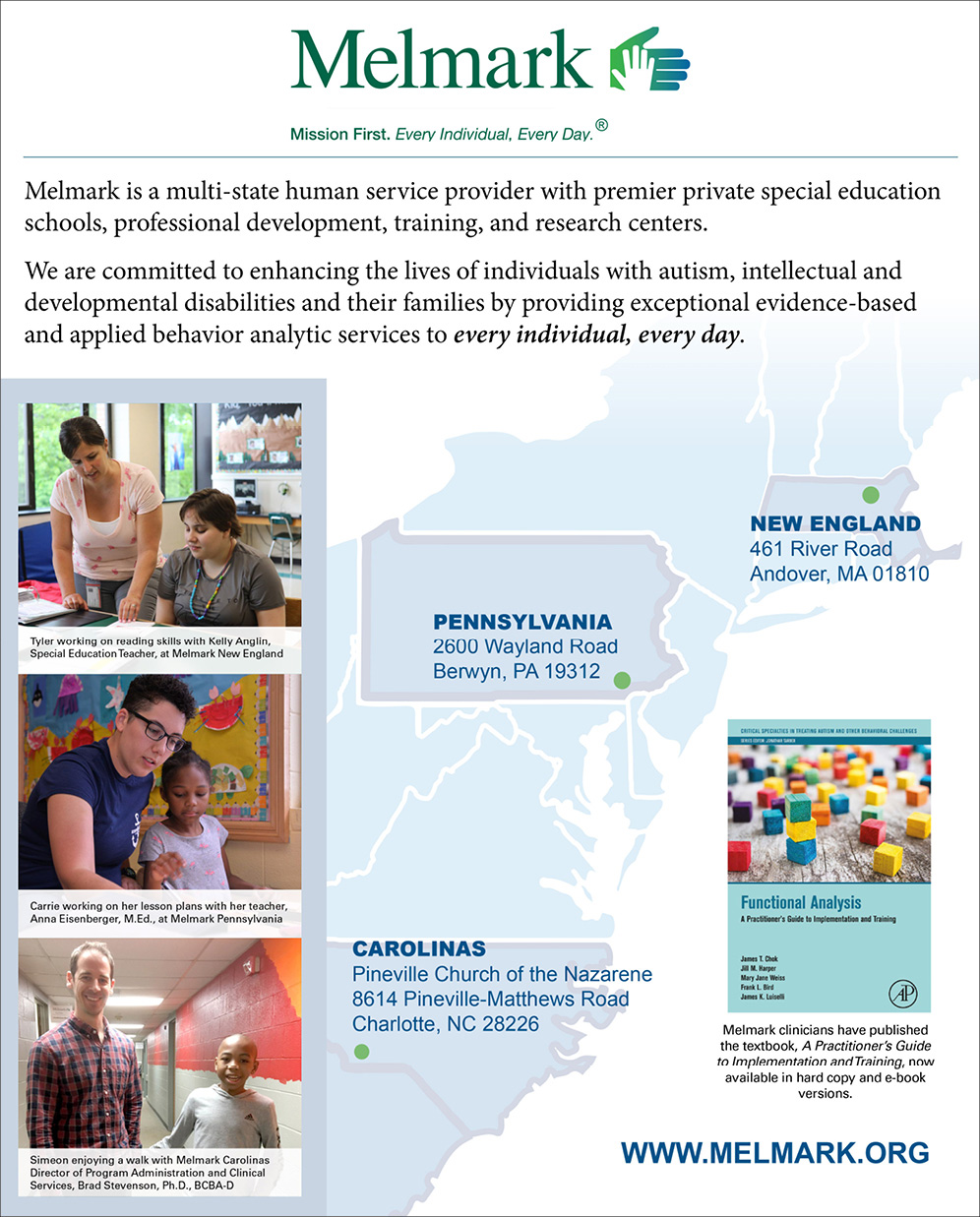Though a small percentage, some individuals with autism and other developmental disabilities can display dangerous challenging behaviors such as high intensity aggression or self-injury. While the field of applied behavior analysis has made great strides in the assessment and treatment of challenging behaviors, effectively applying that technology increases in difficulty as individuals’ profiles become more complex. In addition to a diagnosed developmental disability, those served at Melmark often also have several other factors contributing to their challenging behaviors. These can include co-occurring mental health diagnoses, impaired communication abilities, social skill deficits, unique sensory profiles, and complex medical needs. This means any treatment plan must balance all of these factors, even when the treatment recommendation for one factor contradicts the recommendation for another.

Dr. Bradley Stevenson admires the drawing skills of student Tyler.
Guided by our values as expressed through our core commitments of compassionate care, integrity in everything we do, highly skilled workforce, evidence-based practices, and ensuring best outcomes for all, Melmark built its model to provide this level of comprehensive assessment and treatment for every person who walks through our doors, ensuring them the best chance at a meaningful and productive life.
Assessment
All treatment planning at Melmark begins with thorough assessment. Assessment allows us to understand the person, mapping out their strengths and needs, and finding clues as to why they may be engaging in such dangerous behavior.
Some of the first assessments we conduct are designed to explore what the individual enjoys. These preference assessments help identify reinforcers, but also provide insight into how to design each individual’s day to ensure an enjoyable and supportive environment. Thorough skill assessments are also conducted to determine areas of strength, as well as where additional support and training is necessary for folks to successfully navigate their environment. This can include assessing skills related to adaptive behavior, academics, daily living, social, communication, and more.
As a behavior analytic program, a functional behavior assessment (FBA) also begins immediately to identify environmental variables that may evoke and maintain targeted behaviors. With the complex profiles we serve, initial results are often inconclusive. In this case, individual variables are tested directly via a functional analysis. Identifying these variables is critical to pinpoint exactly what makes certain scenarios so challenging for someone. Once identified, we can effectively prevent some of those scenarios, make those scenarios less aversive when they do occur, and teach skills to navigate those situations more successfully. In addition to analyzing the immediate situations, a comprehensive FBA also includes the assessment of variables that are harder to detect. We systematically collect data and analyze the impacts of factors such as sleep patterns, medication, bowel movements, hydration, and more to include in treatment programming.
It is worth noting this is not an exhaustive list of assessments. If there is a variable that could be important, Melmark has likely assessed it in some way. We regularly develop custom assessments to examine the influence of idiosyncratic variables. For example, when we hypothesized that an individual exhibited challenging behavior to access the physical intervention required to maintain safety, we tested different types of physical interaction, identified the most preferred type, and then taught the individual to request this preferred physical attention instead of exhibiting aggression.
Addressing Unmet Wants and Needs
After assessment, planning begins. The first step in intervention is to ensure access to a healthy, supportive, and enjoyable environment. As such, schedules are developed for individuals that blend instructional, leisure, social, and community activities.
The specifics of how these activities look changes for each individual, guided by assessment results. For instance, instruction is tailored to the person’s skill level and learning profile. Recreational activities and interaction styles incorporate results from preference assessments. Social opportunities are customized to ensure everyone has meaningful social engagement. Plans are created to ensure each person’s medications and health procedures are implemented, diets are adhered to, sleep schedules are implemented and tracked, and more. All of this effort forms the strong foundation upon which all other interventions are added.
This is not always an easy task as challenging behaviors can interfere with an individual’s ability to participate in these activities. However, we remain dedicated and commit the resources necessary to support individuals through their day. If an individual can access this type of environment, the need to engage in challenging behaviors at all decreases dramatically.
Immediate Environmental Adaptations
Even with a strong foundation, challenges still occur. A peer may not respond as anticipated, preferred activities may not always be available, or it may be necessary to work on a skill that is particularly hard for someone. That is why, as part of our compassionate planning, the next step is to look at how to make such situations less aversive.
Targeted interventions to address challenging situations are incorporated. Some empirically-supported strategies to achieve this goal include: reducing the magnitude of aversive stimuli (e.g., dimming bright lights), incorporating preferred stimuli into challenging activities proactively, signaling the length of challenging situations and delay to preferred activities through the use of schedules and visual supports, and providing some level of control through choice making.

Celebrating Brendan’s graduation in 2021. Brendan is the first graduate of Melmark Carolinas.
Teaching and Increasing Appropriate Behaviors
To ensure best outcomes for individuals, we must also include evidence-based skill building. While making the environment supportive and reducing the obstacles challenging situations present is important, teaching the folks we serve how to succeed in a less structured environment is critical for their long-term success. Therefore, once the environment is planned for, we move to planning for skill building.
This is also a two-pronged strategy, encompassing teaching broader, foundational skills alongside skill building targeted for challenging situations. Broadly speaking, the skill assessments inform us of what adaptive skills need to be targeted. For instance, if an individual has difficulty with activities of daily living such as getting dressed, it may be because they lack the ability to perform these tasks fluently. Similarly, an individual may be resistant to solving algebraic formulas or sustaining peer interactions because they do not have the prerequisite skills. In all of these cases, plans are implemented to build the skills to complete these activities.
Simultaneously, we also teach skills that give individuals the ability to respond immediately and appropriately to the challenging situations, to help them navigate those times while the long-term skills are being acquired. For instance, if the FBA reveals an individual becomes aggressive when presented with a task to avoid it, we might teach the individual to ask for short breaks so they can escape the tasks without needing to escalate to aggressive behavior. We may also layer in a reinforcement program for completing the task without exhibiting challenging behaviors. This way the person can get away from the task when they need to, but is still motivated to receive instruction on the task. This way they acquire the skills necessary to complete it independently over time.
For complex individuals, this can take months or years to fully shift to more adaptive options. However, we remain patient and support them through the acquisition of these critical skills because we know it will increase the likelihood of successful long-term, best outcomes.
Responding to Challenging Behaviors Safely
Finally, even with all the proactive supports in place, we must have a plan for how to respond to challenging behavior. Anytime we make a plan to respond to dangerous behavior, we always ensure the safety of the individual and those around them.
Once safety is secured, we plan to ensure any reinforcement received for challenging behaviors is of a lower quality than reinforcement for appropriate behaviors. This is important, as sometimes it is not possible to avoid reinforcing challenging behavior. For instance, if an individual engages in severe self-injury to access attention, staff must intervene to protect that person, thus providing some level of attention for safety. However, such interactions should be more neutral if challenging behavior is occurring while high-quality attention should be available throughout the day and provided immediately following appropriate behavior. In this way, the individual is likely to learn that the better option is to use appropriate behavior to gain access to high-quality attention.
Last, we constantly review plans to ensure individual rights are protected. Due to the complexity of the population Melmark serves, interventions that are more restrictive than we would like, such as non-violent physical intervention, are sometimes necessary. The decision to use restrictive interventions is never taken lightly, and always weighed in consideration with every individual’s rights. As such, we regularly review interventions to ensure every step is taken to protect people’s rights when a restrictive procedure is called for.

Dr. Bradley Stevenson and Simeon walk through the halls of Melmark Carolinas.
Ongoing Data Monitoring
All of the work described thus far is a fair description of what goes into making a plan for individuals we serve. However, it does not end there. Our staff must be trained to implement the plan. With so many different components, this is no small feat, which is why we ensure all of our staff are highly skilled through extensive and ongoing training.
Data collection occurs in real time on all of the metrics that have been targeted including rates of challenging behaviors, acquisition of new skills, physiological factors, safety indicators, and more. These data are reviewed on a biweekly basis to ensure progress. This rigorous data collection and review allows us to pivot as needed to respond to the shifting needs of those we serve. It also allows us to identify issues that may have been masked initially. As our plan controls for so many variables, new patterns of responding can reveal additional factors. For example, a person may come to us exhibiting high rates of challenging behaviors across a myriad of activities. However, once we control for the majority of the operant variables, we can see challenges consolidate around certain activities such as bathroom trips. A medical follow up may diagnose an undetected condition, allowing for us to put the final piece of the puzzle of treatment into place.
Conclusion
The process described here is intensive. The layers of assessment and intervention requires significant skill and investment to ensure it is done with fidelity. Adhering to our core commitments, this is the only way to proceed to ensure those we serve achieve the best outcomes possible.
Foremost, this means having compassionate care as the basis of our intervention plans. Compassionate care begins with foundational values including humane treatment, the preservation of dignity, and a focus on increasing choice, control, and competence. It extends to maximizing the individual’s agency and involvement in their care, incorporating preferences and choices into every aspect of intervention, and involving the individual in their own care and treatment planning in every way possible. It also applies to responding to challenging behaviors, where interventions are administered in the context of humane care that focuses on maximizing the individual’s quality of life.
With compassion as the foundation, we look to our other commitments to ensure successful implementation of those compassionate and comprehensive plans. This means selecting interventions that are supported by evidence so they have the best chance at success. It also means investing in a highly-skilled workforce, which allows us to be confident that our staff have the skills and sophistication to craft such nuanced plans and implement them fidelity. Finally, it means administering every step of the process with integrity, so they we are able to deliver the highest quality services to every individual, every day.
Resources
For further reading, see the following resources addressing compassionate care, essential components of a behavior plan, and a model for comprehensive behavior planning.
- LeBlanc, L. A., Taylor, B. A., and Marchese, N. V. (2020). The training experiences of behavior analysts: Compassionate care and therapeutic relationships with caregivers. Behavior Analysis in Practice, 13, 387-393.
- O’Neill, R. E., Albin, R. W., Storey, K., Horner, R. H., & Sprague, J. R. (2014). Functional assessment and program development. Cengage Learning.
- Quigley, S. P., Ross, R. K., Field, S., & Conway, A. A. (2018). Toward an understanding of the essential components of behavior analytic service plans. Behavior Analysis in Practice, 11, 436-444.
- Taylor, B. A., LeBlanc, L. A., & Nosik, M. R. (2019). Compassionate care in behavior analytic treatment: Can outcomes be enhanced by attending to relationships with caregivers? Behavior Analysis in Practice, 12, 654-666.
Bradley S. Stevenson, PhD, BCBA-D, is Director of Program Administration and Clinical Services, Jill Harper, PhD, BCBA-D, LABA, is Senior Director of Professional Development, Kylee Formento, MA, BCBA, is Director of Children’s Clinical Services, Shawn P. Quigley, PhD, BCBA-D, is Executive Director, PA Division, and Frank L. Bird, MEd, BCBA, LABA, is Vice President & Chief Clinical Officer at Melmark Inc. For more information, please visit www.melmark.org.





